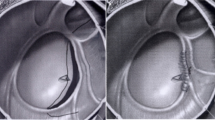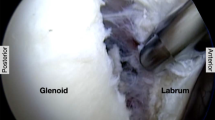Abstract
Purpose
The optimal strategy for surgical repair of traumatic anterior shoulder instability remains controversial. While several study groups have reported that the clinical and radiological outcomes of arthroscopic procedures performed with two anchors are not fully adequate, these conclusions are not supported by the findings published in other studies. A prospective randomized study was conducted to compare the structural and clinical outcomes of surgical procedures involving two vs. three anchors.
Methods
Patients who underwent arthroscopic Bankart repair were randomly assigned to either Group I, which underwent procedures involving two double-loaded 3.5-mm knotless anchors, or Group II, which underwent procedures involving three single-loaded 2.9-mm knotless anchors. All patients underwent bilateral MRI assessments at a minimum of 12 months and clinical assessment at a minimum of 24 months postoperatively. To evaluate the reconstruction of the labral capsular ligamentous complex (LCLC), the labrum-glenoid height index (LGHI), restored labral height (LH), and labral slope (LS) were measured for both shoulders. For clinical assessment, the redislocation rate and functional outcome scores (Constant score (CS), American Shoulder and Elbow Surgeon score (ASES), Walch Duplay score (WDS), and Rowe score (RS)) were evaluated at follow-up visits.
Results
Bankart repair with two knotless anchors showed lower values for anterior reconstruction of the LCLC compared to the uninjured contralateral shoulder. Likewise, significant differences were noted when comparing these measurements to those from patients who underwent reconstruction with three anchors. No differences were demonstrated with regard to the reconstruction of the inferior LCLC. Clinical assessment showed good to excellent results in both groups. In total, three patients experienced redislocation of the shoulder: two in group I and one in group II. No significant differences were found with respect to clinical outcomes and redislocation rates.
Conclusion
Bankart repair with both two and three knotless anchors results in effective anatomical reconstruction of the labral capsular ligamentous complex. Although the two-anchor technique yields significantly lower values for the anterior portion compared with the contralateral side, none of these differences reach clinical relevance as per our original definition.




Similar content being viewed by others
Data availability
The data that support the findings of this study are available on request from the corresponding author (JB).
Code availability
The datasets generated during and/or analysed during the current study are available from the corresponding author (JB) on reasonable request.
References
Ho AG, Gowda AL, Michael Wiater J (2016) Evaluation and treatment of failed shoulder instability procedures. J Orthop Traumatol 17:187–197. https://doi.org/10.1007/s10195-016-0409-8
Kroner K, Lind T, Jensen J (1989) The epidemiology of shoulder dislocations. Arch Orthop Trauma Surg 108:288–290. https://doi.org/10.1007/BF00932317
Liavaag S, Svenningsen S, Reikerås O, Enger M, Fjalestad T, Pripp AH, Brox JI (2011) The epidemiology of shoulder dislocations in Oslo. Scand J Med Sci Sports 21:e334–e340. https://doi.org/10.1111/j.1600-0838.2011.01300.x
Owens BD, Nelson BJ, Duffey ML, Mountcastle SB, Taylor DC, Cameron KL, Campbell S, DeBerardino TM (2010) Pathoanatomy of first-time, traumatic, anterior glenohumeral subluxation events. J Bone Joint Surg Am 92:1605–1611. https://doi.org/10.2106/JBJS.I.00851
Taylor DC, Arciero RA (1997) Pathologic changes associated with shoulder dislocations. Arthroscopic and physical examination findings in first-time, traumatic anterior dislocations. Am J Sports Med 25:306–311. https://doi.org/10.1177/036354659702500306
Bankart ASB (1938) Pathology and treatment of recurrent dislocation of the shoulder joint. Br J Surg 26:23–29
Park JY, Chung SW, Lee JS, Oh KS, Lee JH (2019) Comparison of clinical and radiographic outcomes of vertical simple stitch versus modified mason-allen stitch in arthroscopic Bankart repairs: a prospective randomized controlled study. Am J Sports Med 47:398–407. https://doi.org/10.1177/0363546518816679
Yoo JC, Lee YS, Tae SK, Park JH, Park JW, Ha HC (2008) Magnetic resonance imaging appearance of a repaired capsulolabral complex after arthroscopic Bankart repair. Am J Sports Med 36:2310–2316. https://doi.org/10.1177/0363546508322477
Howell SM, Galinat BJ (1989) The glenoid-labral socket. A constrained articular surface. Clin Orthop Relat Res 243:122–125
Fehringer EV, Schmidt GR, Boorman RS, Churchill S, Smith KL, Norman AG, Sidles JA, Matsen FA 3rd (2003) The anteroinferior labrum helps center the humeral head on the glenoid. J Shoulder Elbow Surg 12:53–58. https://doi.org/10.1067/mse.2003.128196S1058274602868690
Lippitt S, Matsen F (1993) Mechanisms of glenohumeral joint stability. Clin Orthop Relat Res 291:20–28
Castagna A, Garofalo R, Conti M, Flanagin B (2016) Arthroscopic Bankart repair: Have we finally reached a gold standard? Knee Surg Sports Traumatol Arthrosc 24:398–405. https://doi.org/10.1007/s00167-015-3952-6
Kim JY, Chung SW, Kwak JY (2014) Morphological characteristics of the repaired labrum according to glenoid location and its clinical relevance after arthroscopic Bankart repair: postoperative evaluation with computed tomography arthrography. Am J Sports Med 42:1304–1314. https://doi.org/10.1177/0363546514528791
Stein T, Mehling AP, Reck C, Buckup J, Efe T, Hoffmann R, Jager A, Welsch F (2011) MRI assessment of the structural labrum integrity after Bankart repair using knotless bio-anchors. Knee Surg Sports Traumatol Arthrosc 19:1771–1779. https://doi.org/10.1007/s00167-011-1407-2
Boileau P, Villalba M, Hery JY, Balg F, Ahrens P, Neyton L (2006) Risk factors for recurrence of shoulder instability after arthroscopic Bankart repair. J Bone Joint Surg Am 88:1755–1763. https://doi.org/10.2106/JBJS.E.00817
Randelli P, Ragone V, Carminati S, Cabitza P (2012) Risk factors for recurrence after Bankart repair a systematic review. Knee Surg Sports Traumatol Arthrosc 20:2129–2138. https://doi.org/10.1007/s00167-012-2140-1
Witney-Lagen C, Perera N, Rubin S, Venkateswaran B (2014) Fewer anchors achieves successful arthroscopic shoulder stabilization surgery: 114 patients with 4 years of follow-up. J Shoulder Elbow Surg 23:382–387. https://doi.org/10.1016/j.jse.2013.08.010
Snyder SJ, Karzel RP, Del Pizzo W, Ferkel RD, Friedman MJ (1990) SLAP lesions of the shoulder. Arthroscopy 6:274–279
Scheibel M, Nikulka C, Dick A, Schroeder RJ, Popp AG, Haas NP (2007) Structural integrity and clinical function of the subscapularis musculotendinous unit after arthroscopic and open shoulder stabilization. Am J Sports Med 35:1153–1161. https://doi.org/10.1177/0363546507299446
Stein T, Buckup J, Efe T, von Eisenhart-Rothe R, Hoffmann R, Zimmermann E, Welsch F (2015) Structural and clinical integrity of the rotator cuff in athletes after arthroscopic Bankart repair using the three-portal technique. Arch Orthop Trauma Surg 135:369–382. https://doi.org/10.1007/s00402-015-2158-1
Stein T, Buckup J, Mehling AP, Hoffmann R, Efe T, von Eisenhart-Rothe R, Welsch F (2014) Restoration of joint congruency and the glenoidal labrum after arthroscopic revision Bankart repair: A MRI match-paired analysis comparing primary Bankart repair and the uninjured labrum. Arch Orthop Trauma Surg 134:1121–1134. https://doi.org/10.1007/s00402-014-1990-z
Bock J, Buckup J, Reinig Y, Zimmermann E, Colcuc C, Hoffmann R, Welsch F, Stein T (2018) The arthroscopic Bankart repair procedure enables complete quantitative labrum restoration in long-term assessments. Knee Surg Sports Traumatol Arthrosc 26:3788–3796. https://doi.org/10.1007/s00167-018-4922-6
Rowe CR, Patel D, Southmayd WW (1978) The Bankart procedure: A long-term end-result study. J Bone Joint Surg Am 60:1–16
Lazarus MD, Sidles JA, Harryman DT 2nd, Matsen FA 3rd (1996) Effect of a chondral-labral defect on glenoid concavity and glenohumeral stability. A cadaveric model. J Bone Joint Surg Am 78:94–102. https://doi.org/10.2106/00004623-199601000-00013
Metcalf MH, Pon JD, Harryman DT 2nd, Loutzenheiser T, Sidles JA (2001) Capsulolabral augmentation increases glenohumeral stability in the cadaver shoulder. J Shoulder Elbow Surg 10:532–538. https://doi.org/10.1067/mse.2001.118411
Vaswani R, Gasbarro G, Como C, Golan E, Fourman M, Wilmot A, Borrero C, Vyas D, Lin A (2020) Labral morphology and number of preoperative dislocations are associated with recurrent instability after arthroscopic Bankart repair. Arthroscopy 36:993–999. https://doi.org/10.1016/j.arthro.2019.11.111
Fritsch BA, Arciero RA, Taylor DC (2010) Glenoid rim fracture after anchor repair: a report of 4 cases. Am J Sports Med 38:1682–1686. https://doi.org/10.1177/0363546510364239
Grumet RC, Bach BR Jr, Provencher MT (2010) Arthroscopic stabilization for first-time versus recurrent shoulder instability. Arthroscopy 26:239–248. https://doi.org/10.1016/j.arthro.2009.06.006
Kamath GV, Hoover S, Creighton RA, Weinhold P, Barrow A, Spang JT (2013) Biomechanical analysis of a double-loaded glenoid anchor configuration: can fewer anchors provide equivalent fixation? Am J Sports Med 41:163–168. https://doi.org/10.1177/0363546512469090
Lee WY, Shin HD, Kim KC, Cha SM, Jeon YS, Song JH (2022) Repair integrity and functional outcomes of arthroscopic repair in chronic anterior shoulder instability: single-loaded versus double-loaded single-row repair. Arch Orthop Trauma Surg 142:131–138. https://doi.org/10.1007/s00402-020-03661-7
Nho SJ, Frank RM, Van Thiel GS, Wang FC, Wang VM, Provencher MT, Verma NN (2010) A biomechanical analysis of anterior Bankart repair using suture anchors. Am J Sports Med 38:1405–1412. https://doi.org/10.1177/0363546509359069
Funding
None of the authors received any funding or sponsorship for this study, including funds or materials.
Author information
Authors and Affiliations
Contributions
All authors have contributed substantially to the conception, design, analysis, and interpretation of the data in this manuscript and will take public responsibility for the content. Each author knows that the manuscript represents honest work. All authors read and approved the final manuscript.
Corresponding author
Ethics declarations
Ethics approval and consent to participate
Approval giving authority and the Study Number: Ethik-Kommission der Landesärztekammer Hessen (FF14/ 2013).
Consent for publication
Informed consent was obtained from all individual participants included in the study.
Conflicts of interest
The authors declare that they have no conflicts of interest.
Additional information
Publisher's note
Springer Nature remains neutral with regard to jurisdictional claims in published maps and institutional affiliations.
Rights and permissions
Springer Nature or its licensor (e.g. a society or other partner) holds exclusive rights to this article under a publishing agreement with the author(s) or other rightsholder(s); author self-archiving of the accepted manuscript version of this article is solely governed by the terms of such publishing agreement and applicable law.
About this article
Cite this article
Buckup, J., Welsch, F., Petchennik, S. et al. Arthroscopic Bankart repair: how many knotless anchors do we need for anatomic reconstruction of the shoulder?—a prospective randomized controlled study. International Orthopaedics (SICOT) 47, 1285–1293 (2023). https://doi.org/10.1007/s00264-023-05749-2
Received:
Accepted:
Published:
Issue Date:
DOI: https://doi.org/10.1007/s00264-023-05749-2




